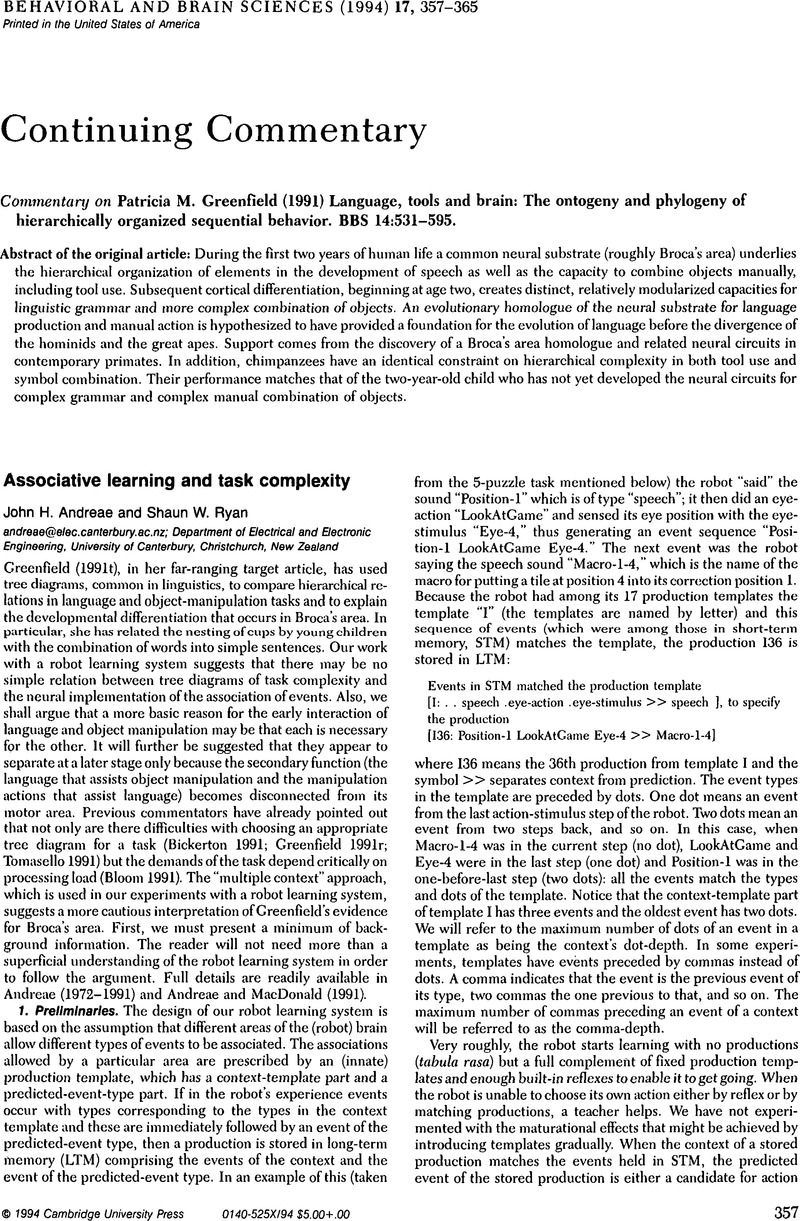Crossref Citations
This article has been cited by the following publications. This list is generated based on data provided by Crossref.
Leiber, Justin
1995.
Coming of age in Olduvai and the Zaire rain forest.
Behavioral and Brain Sciences,
Vol. 18,
Issue. 1,
p.
196.
Westergaard, Gregory Charles
1995.
The stone‐tool technology of capuchin monkeys: Possible implications for the evolution of symbolic communication in hominids.
World Archaeology,
Vol. 27,
Issue. 1,
p.
1.
Liska, Jo
1995.
Semiogenesis as a continuous, not a discrete, phenomenon.
Behavioral and Brain Sciences,
Vol. 18,
Issue. 1,
p.
198.
Dingwall, William O.
1995.
Complex behaviors: Evolution and the brain.
Behavioral and Brain Sciences,
Vol. 18,
Issue. 1,
p.
186.
Wilkins, Wendy K.
and
Wakefield, Jennie
1995.
Issues and nonissues in the origins of language.
Behavioral and Brain Sciences,
Vol. 18,
Issue. 1,
p.
205.
Fitch, Roslyn Holly
and
Tallal, Paula
1995.
A case for auditory temporal processing as an evolutionary precursor to speech processing and language function.
Behavioral and Brain Sciences,
Vol. 18,
Issue. 1,
p.
189.
Bickerton, Derek
1995.
Finding the true place ofHomo habilisin language evolution.
Behavioral and Brain Sciences,
Vol. 18,
Issue. 1,
p.
182.
Gibson, Kathleen R.
1995.
Solving the language origins puzzle: Collecting and assemblingallpertinent pieces.
Behavioral and Brain Sciences,
Vol. 18,
Issue. 1,
p.
189.
Bryant, David J.
1995.
Is preadaptation for language a necessary assumption?.
Behavioral and Brain Sciences,
Vol. 18,
Issue. 1,
p.
183.
Newmeyer, Frederick J.
1995.
Conceptual structure and syntax.
Behavioral and Brain Sciences,
Vol. 18,
Issue. 1,
p.
202.
Jacobs, Bob
and
Horner, John M.
1995.
Language as a multimodal sensory enhancement system.
Behavioral and Brain Sciences,
Vol. 18,
Issue. 1,
p.
194.
Hauser, Marc D.
and
Wolfea, Nathan D.
1995.
Human language: Are nonhuman precursors lacking?.
Behavioral and Brain Sciences,
Vol. 18,
Issue. 1,
p.
190.
Jerison, Harry J.
1995.
Issues in neo- and paleoneurology of language.
Behavioral and Brain Sciences,
Vol. 18,
Issue. 1,
p.
195.
Mitchell, Robert W.
and
Miles, H. Lyn
1995.
Apes and language: Human uniqueness again?.
Behavioral and Brain Sciences,
Vol. 18,
Issue. 1,
p.
200.
Wilkins, Wendy K.
and
Wakefield, Jennie
1995.
Brains evolution and neurolinguistic preconditions.
Behavioral and Brain Sciences,
Vol. 18,
Issue. 1,
p.
161.
Catania, A. Charles
1995.
Single words, multiple words, and the functions of language.
Behavioral and Brain Sciences,
Vol. 18,
Issue. 1,
p.
184.
Donald, Merlin
1995.
Neurolinguistic models and fossil reconstructions.
Behavioral and Brain Sciences,
Vol. 18,
Issue. 1,
p.
188.
Lieberman, Philip
1995.
Manual versus speech motor control and the evolution of language.
Behavioral and Brain Sciences,
Vol. 18,
Issue. 1,
p.
197.
Maryanski, A.
1995.
The hominid tool-language connection: Some missing evolutionary links?.
Behavioral and Brain Sciences,
Vol. 18,
Issue. 1,
p.
199.
Corballis, Michael C.
1995.
Lending a hand.
Behavioral and Brain Sciences,
Vol. 18,
Issue. 1,
p.
185.





